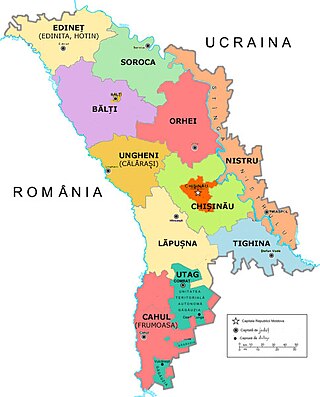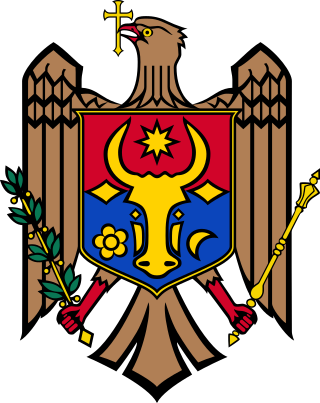Top Qs
Timeline
Chat
Perspective
Administrative divisions of Moldova
From Wikipedia, the free encyclopedia
Remove ads
Moldova is divided administratively into two levels:[1][2][3]
- First level:
- 32 districts or raions (Romanian: raioane)
- 3 municipalities (municipii)—specifically Chișinău, Bălți, and Bender
- 2 autonomous territorial units: Gagauzia and Left Bank of the Dniester (de facto Transnistria, which is not under control of the government of Moldova)
- Second level:
- Villages (Romanian: sate); two or more villages can form together a commune (Romanian: comună)[4]
- Sectors[citation needed]
- 10 municipalities (municipii)
- Cities and towns

Remove ads
Localities

Moldova has a total of 1,682 localities; from these 982 are incorporated (de jure with 982 mayors and 982 local councils), including 53 cities/towns, other 13 cities with municipality status (see municipiu), and 916 rural localities.[5] They cover the entire area of the country. A number of villages are self-governed, while others 700 villages are too small to have a separate administration, and are part of either cities/towns/municipalities (41 of them) or communes (659). Few localities are inhabited.
Remove ads
Current divisions
Summarize
Perspective
In the administrative-territorial structure of Moldova are 898 second-level administrative territorial units (cities/towns, sectors and villages/communes).[6]
The status of Chișinău, Bălți, and Tighina as municipalities and first-level territorial units of the country allows their suburb villages to have, when large enough, their own mayor and local council. By contrast, the villages that are administratively part of (some of) the other cities do not retain self-rule.
- Districts (32):
- District-level municipalities (3):
- Autonomous territorial units (2):
¹ Tighina and the Administrative-Territorial Units of the Left Bank of the Dniester are under the control of the unrecognized separatist Pridnestrovian Moldavian Republic (PMR, also known as Transnistria). There, Tighina is known as Bender.
Areas not under central government control
- Transnistria, which with the exception of six communes (comprising a total of ten localities) corresponds to the geographic part of Moldova situated to the east of the Dniestr (Romanian: Nistru) river, is de jure a part of Moldova, but in fact is governed by breakaway authorities (see also: War of Transnistria). The city of Dubăsari (geographically and administratively in Transnistria, and not in the Dubăsari District), and six communes (administratively in the Dubăsari District of Moldova, and not in the administrative definition of Transnistria), all controlled by the central authorities (except the village of Roghi in commune Molovata Nouă, which is controlled by Tiraspol), form the northern part of the security zone set at the end of the war.
- Tighina municipality (the city itself, plus the commune Proteagailovca), and three communes (five localities) of Căușeni District (Gîsca, Chițcani, and Cremenciug) are de facto controlled by the breakaway regime of Transnistria. Together with the commune Varnița of Anenii Noi District and the commune Copanca of Căușeni District under Moldovan control, these localities form the southern part of the security zone set at the end of the war. The city of Tighina has both a Moldovan police force (mostly symbolic) and a Transnistrian militsiya force (practically in charge in most instances). In Transnistria, Tighina is known as Bender.
Population
- The smallest entity electing a mayor is the commune of Salcia, in Taraclia District (population 441). It consists of the village of Salcia, population 382, and the village of Orehovca, population 59. The largest entity is the municipality of Chișinău, electing a mayor for 712,218 inhabitants.
- The largest number of localities governed by a single commune or city government in Moldova is 6. This is the case for:
- city of Anenii Noi, population 11,463, of which 3,105 in the 5 suburban villages
- commune Copăceni, Sîngerei District, population 3,315
- commune Natalievca, Fălești District, population 2,231
- commune Tătărăuca Veche, Soroca District, population 2,203
- On the opposite end, 42 of the 66 cities, and about half the communes of Moldova have local administration providing services for a single locality.
- There are four or five localities in Moldova with a zero population:
- village Armanca, commune Vasileuți, Rîșcani District
- village Chetrișul Nou, commune Chetriș, Fălești District
- village Pelinia, loc. st. c. f., commune Pelinia, Drochia District
- village Stălinești, commune Corestăuți, Ocnița District
- The village of Schinoasa was outlined within commune Țibirica, Călărași District in 2007, and information is not available yet whether it has any population.
- Village (hamlet) Ivanovca, commune Natalievca, Fălești District, population 19, inhabited by 14 Russians and 5 Ukrainians, is the only inhabited locality in Moldova without any ethnic Moldovans. On the opposite end, one commune, Cigîrleni, Ialoveni District, population 2,411, and 42 villages of sub-commune level (population varying from 1 to 673), have a 100% Moldovan population.
Duplicate names
There are 147 settlement names shared by multiple localities in Moldova. Most notable cases includes these:
- A town Mărculești, and a different commune Mărculești, both situated in the Florești District
- A city Dondușeni, and a different commune Dondușeni, both situated in the Dondușeni District
- A city Drochia, and a different commune Drochia, both situated in the Drochia District
- A town Costești, in Rîșcani District, with a population of 2,247 (4,109 with 4 suburb villages), the 8th smallest city in Moldova, and a commune (village) Costești, in Ialoveni District, population 11,128, the 2nd largest village in Moldova
- A town Cornești, in Ungheni District, and a different village Cornești in the same Ungheni District, and also a village Cornești in Hîncești District
- etc.
Remove ads
Regions
The first-level units are grouped into three regions:[10]
|
|
Previous divisions
Summarize
Perspective
Counties (1998-2003)

Between 1998 and February 2003, Moldova was divided into 12 territorial units, including 1 municipality, 1 autonomous territorial unit, 1 territorial unit, and 9 counties (Romanian: județe; seats in brackets):
- Chișinău municipality, surrounded by Chișinău county, but different from it
- Bălți County (Bălți)
- Cahul County (Cahul)
- Chișinău County (Chișinău)
- Edineț County (Edineț)
- Lăpușna County (Hîncești)
- Orhei County (Orhei)
- Soroca County (Soroca)
- Tighina County (Moldova) (Căușeni)
- Ungheni County (Ungheni)
- Găgăuzia, autonomous territorial unit (Comrat)
- Left Bank of the Dniester, territorial unit (Tiraspol)
In October 1999, Taraclia County was split out from the Cahul County; it coincides with the current Taraclia District.
Cities and districts (1991-1998)
Between 1991 and 1998, Moldova was divided into 10 cities and 40 districts:[12]
- Cities
- Districts
- Anenii Noi
- Basarabeasca
- Brinceni
- Cahul
- Camenca
- Cantemir
- Căinari
- Călărași
- Căușeni
- Ceadîr-Lunga
- Cimișlia
- Comrat
- Criuleni
- Dondușeni
- Drochia
- Dubăsari
- Edineț
- Fălești
- Florești
- Glodeni
- Grigoriopol
- Hîncești
- Ialoveni
- Leova
- Nisporeni
- Ocnița
- Orhei
- Rezina
- Rîbnița
- Rîșcani
- Sîngerei
- Slobozia
- Soroca
- Strășeni
- Șoldănești
- Ștefan Vodă
- Taraclia
- Telenești
- Ungheni
- Vulcănești
2017 expansion
Besides Chișinău, Bălți, Tighina, Comrat, and Tiraspol, on 13 April 2017 eight more became municipalities: Cahul, Ceadîr-Lunga, Edineț, Hîncești, Orhei, Soroca, Strășeni, and Ungheni.[13]
Remove ads
See also
- ISO 3166-2:MD, ISO subdivision codes for Moldova
References
External links
Wikiwand - on
Seamless Wikipedia browsing. On steroids.
Remove ads
